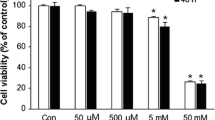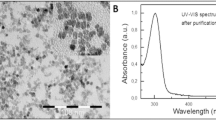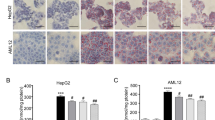Abstract
Trivalent chromium [Cr(III)] is recognized as an essential trace element for human health, whereas its effect on hepatic lipid metabolism has not yet been fully understood. This study aimed to investigate the beneficial effects and potential mechanisms of Cr(III) on hepatic steatosis in an oleic acid (OA) induced mice model. Mice were fed with high OA for 12 weeks to induce lipid accumulation, and co-administrated with Cr(III) supplementation. Indexes of liver lipid accumulation, associated lipid genes expression, fatty acids (FAs) profile and inflammatory cytokines were analyzed. The data showed that Cr(III) supplementation could attenuate disease progress of hepatic steatosis and protect liver from high OA. After Cr(III) supplementation, elevated body weight and liver injury in steatosis mice were reversed, excessive lipid accumulation and FAs were also reduced. The up-regulation of cluster of differentiation 36 (CD36) and diacylglycerol acyltransferase 2 (DGAT2) following steatosis induction were inhibited by Cr(III). Cr(III) reduced the content of pro-inflammatory cytokines (IL-1β and TNF-α, IL-12) and restored the level of anti-inflammatory cytokine (IL-10) to the control values. Our results suggest that Cr(III) supplementation is a novel strategy for alleviating OA-induced hepatic steatosis.






Similar content being viewed by others
References
Angulo P (2002) Nonalcoholic fatty liver disease. N Engl J Med 346(16):1221–1231. https://doi.org/10.1056/NEJMra011775
Feldstein AE, Canbay A, Guicciardi ME, Higuchi H, Bronk SF, Gores GJ (2003) Diet associated hepatic steatosis sensitizes to Fas mediated liver injury in mice. J Hepatol 39(6):978–983
Li Z, Yang S, Lin H, Huang J, Watkins PA, Moser AB, Desimone C, Song XY, Diehl AM (2003) Probiotics and antibodies to TNF inhibit inflammatory activity and improve nonalcoholic fatty liver disease. Hepatology 37(2):343–350. https://doi.org/10.1053/jhep.2003.50048
Pan MH, Lai CS, Ho CT (2010) Anti-inflammatory activity of natural dietary flavonoids. Food Funct 1(1):15–31. https://doi.org/10.1039/c0fo00103a
Pechova A, Pavlata L (2007) Chromium as an essential nutrient: a review. Veterinarni Medicina 52(1):1–18
Roussel AM, Andriollo-Sanchez M, Ferry M, Bryden NA, Anderson RA (2007) Food chromium content, dietary chromium intake and related biological variables in French free-living elderly. Br J Nutr 98(2):326–331. https://doi.org/10.1017/S000711450770168X
Mahdi GS (1996) Chromium deficiency might contribute to insulin resistance, type 2 diabetes mellitus, dyslipidaemia, and atherosclerosis. Diabet Med 13(4):389–390. https://doi.org/10.1002/(SICI)1096-9136(199604)13:4<389::AID-DIA65>3.0.CO;2-J
Abraham AS, Brooks BA, Eylath U (1992) The effects of chromium supplementation on serum glucose and lipids in patients with and without non-insulin-dependent diabetes. Metabolism 41(7):768–771
Shafik NM, Baalash A, Ebeid AM (2017) Synergistic Cardioprotective effects of combined chromium Picolinate and atorvastatin treatment in triton X-100-induced hyperlipidemia in rats: impact on some biochemical markers. Biol Trace Elem Res 180(2):255–264. https://doi.org/10.1007/s12011-017-1010-6
Bligh EG, Dyer WJ (1959) A rapid method of total lipid extraction and purification. Can J Biochem Physiol 37(8):911–917. https://doi.org/10.1139/o59-099
Wang ZQ, Qin J, Martin J, Zhang XH, Sereda O, Anderson RA, Pinsonat P, Cefalu WT (2007) Phenotype of subjects with type 2 diabetes mellitus may determine clinical response to chromium supplementation. Metabolism 56(12):1652–1655. https://doi.org/10.1016/j.metabol.2007.07.007
Sadri H, Larki NN, Kolahian S (2017) Hypoglycemic and Hypolipidemic effects of leucine, zinc, and chromium, alone and in combination, in rats with type 2 diabetes. Biol Trace Elem Res 180(2):246–254. https://doi.org/10.1007/s12011-017-1014-2
Mertz W (1993) Chromium in human nutrition: a review. J Nutr 123(4):626–633
Chen WY, Chen CJ, Liao JW, Mao FC (2009) Chromium attenuates hepatic damage in a rat model of chronic cholestasis. Life Sci 84(17–18):606–614
Wang S, Wang J, Zhang X, Hu L, Fang Z, Huang Z, Shi P (2016) Trivalent chromium alleviates oleic acid induced steatosis in SMMC-7721 cells by decreasing fatty acid uptake and triglyceride synthesis. Biometals 29(5):881–892. https://doi.org/10.1007/s10534-016-9960-2
Araya J, Rodrigo R, Videla LA, Thielemann L, Orellana M, Pettinelli P, Poniachik J (2004) Increase in long-chain polyunsaturated fatty acid n - 6/n - 3 ratio in relation to hepatic steatosis in patients with non-alcoholic fatty liver disease. Clin Sci (Lond) 106(6):635–643. https://doi.org/10.1042/CS20030326
Reddy JK, Rao MS (2006) Lipid metabolism and liver inflammation. II. Fatty liver disease and fatty acid oxidation. Am J Physiol Gastrointest Liver Physiol 290(5):G852–G858. https://doi.org/10.1152/ajpgi.00521.2005
Ruiz-Gutiérrez V, Pérez-Espinosa A, Vázquez CM, Santa-María C (1999) Effects of dietary fats (fish, olive and high-oleic-acid sunflower oils) on lipid composition and antioxidant enzymes in rat liver. Br J Nutr 82:233–241
Ducheix S, Montagner A, Polizzi A, Lasserre F, Régnier M, Marmugi A, Benhamed F, Bertrand-Michel J, Mselli-Lakhal L, Loiseau N, Martin PG, Lobaccaro JM, Ferrier L, Postic C, Guillou H (2017) Dietary oleic acid regulates hepatic lipogenesis through a liver X receptordependent signaling. PLoS One 12. https://doi.org/10.1371/journal.pone.0181393
Chen WY, Chen CJ, Liu CH, Mao FC (2010) Chromium attenuates high-fat diet-induced nonalcoholic fatty liver disease in KK/HlJ mice. Biochem Biophys Res Commun 397:459–464. https://doi.org/10.1016/j.bbrc.2010.05.129
Folch J, Lees M, Sloane Stanley GH (1957) A simple method for the isolation and purification of total lipides from animal tissues. J Biol Chem 226(1):497–509
Wang S, Kuang X, Fang Z, Huang Z, Shi P (2014) Effect of oleic acid on the levels of eight metal ions in human hepatoma SMMC-7721 cells. Biol Trace Elem Res 159(1–3):445–450. https://doi.org/10.1007/s12011-014-0018-4
Schwarz K, Mertz W (1959) Chromium(III) and the glucose tolerance factor. Arch Biochem Biophys 85:292–295
Bugianesi E, Manzini P, D'Antico S, Vanni E, Longo F, Leone N, Massarenti P, Piga A, Marchesini G, Rizzetto M (2004) Relative contribution of iron burden, HFE mutations, and insulin resistance to fibrosis in nonalcoholic fatty liver. Hepatology 39(1):179–187. https://doi.org/10.1002/hep.20023
Jensen-Urstad AP, Semenkovich CF (2012) Fatty acid synthase and liver triglyceride metabolism: housekeeper or messenger? Biochim Biophys Acta 1821(5):747–753. https://doi.org/10.1016/j.bbalip.2011.09.017
Wakil SJ, Abu-Elheiga LA (2009) Fatty acid metabolism: target for metabolic syndrome. J Lipid Res 50(Suppl):S138–S143. https://doi.org/10.1194/jlr.R800079-JLR200
Ibrahimi A, Abumrad NA (2002) Role of CD36 in membrane transport of long-chain fatty acids. Curr Opin Clin Nutr Metab Care 5(2):139–145
Iqbal J, Hussain MM (2009) Intestinal lipid absorption. Am J Physiol Endocrinol Metab 296(6):E1183–E1194. https://doi.org/10.1152/ajpendo.90899.2008
Koonen DP, Jacobs RL, Febbraio M, Young ME, Soltys CL, Ong H, Vance DE, Dyck JR (2007) Increased hepatic CD36 expression contributes to dyslipidemia associated with diet-induced obesity. Diabetes 56(12):2863–2871. https://doi.org/10.2337/db07-0907
Buque X, Martinez MJ, Cano A, Miquilena-Colina ME, Garcia-Monzon C, Aspichueta P, Ochoa B (2010) A subset of dysregulated metabolic and survival genes is associated with severity of hepatic steatosis in obese Zucker rats. J Lipid Res 51(3):500–513. https://doi.org/10.1194/jlr.M001966
Miquilena-Colina ME, Lima-Cabello E, Sanchez-Campos S, Garcia-Mediavilla MV, Fernandez-Bermejo M, Lozano-Rodriguez T, Vargas-Castrillon J, Buque X, Ochoa B, Aspichueta P, Gonzalez-Gallego J, Garcia-Monzon C (2011) Hepatic fatty acid translocase CD36 upregulation is associated with insulin resistance, hyperinsulinaemia and increased steatosis in non-alcoholic steatohepatitis and chronic hepatitis C. Gut 60(10):1394–1402. https://doi.org/10.1136/gut.2010.222844
Yen C-LE, Stone SJ, Koliwad S, Harris C, Farese RV (2008) Thematic review series: glycerolipids. DGAT enzymes and triacylglycerol biosynthesis. J Lipid Res 49(11):2283–2301
Mo X, Yang C, Wang X, Burkhardt BR, Li Y, Xia H, Cao X (2015) F3MB(PANDER) decreases mice hepatic triglyceride and is associated with decreased DGAT1 expression. PLoS One 10(2):e0117156. https://doi.org/10.1371/journal.pone.0117156
Zhao Y, Pan Y, Yang Y, Batey R, Wang J, Li Y (2015) Treatment of rats with Jiangzhi capsule improves liquid fructose-induced fatty liver: modulation of hepatic expression of SREBP-1c and DGAT-2. J Transl Med 13:174. https://doi.org/10.1186/s12967-015-0529-6
Stone SJ, Myers HM, Watkins SM, Brown BE, Feingold KR, Elias PM, Farese RV (2004) Lipopenia and skin barrier abnormalities in DGAT2-deficient mice. J Biol Chem 279(12):11767–11776
Choi CS, Savage DB, Kulkarni A, Yu XX, Liu ZX, Morino K, Kim S, Distefano A, Samuel VT, Neschen S, Zhang D, Wang A, Zhang XM, Kahn M, Cline GW, Pandey SK, Geisler JG, Bhanot S, Monia BP, Shulman GI (2007) Suppression of diacylglycerol acyltransferase-2 (DGAT2), but not DGAT1, with antisense oligonucleotides reverses diet-induced hepatic steatosis and insulin resistance. J Biol Chem 282(31):22678–22688. https://doi.org/10.1074/jbc.M704213200
Choi YJ, Lee CH, Lee KY, Jung SH, Lee BH (2015) Increased hepatic fatty acid uptake and esterification contribute to tetracycline-induced steatosis in mice. Toxicol Sci 145(2):273–282. https://doi.org/10.1093/toxsci/kfv049
Clugston RD, Yuen JJ, Hu Y, Abumrad NA, Berk PD, Goldberg IJ, Blaner WS, Huang LS (2014) CD36-deficient mice are resistant to alcohol- and high-carbohydrate-induced hepatic steatosis. J Lipid Res 55(2):239–246. https://doi.org/10.1194/jlr.M041863
Sato T, Morita A, Mori N, Miura S (2014) The role of glycerol-3-phosphate dehydrogenase 1 in the progression of fatty liver after acute ethanol administration in mice. Biochem Biophys Res Commun 444(4):525–530. https://doi.org/10.1016/j.bbrc.2014.01.096
Ricchi M, Odoardi MR, Carulli L, Anzivino C, Ballestri S, Pinetti A, Fantoni LI, Marra F, Bertolotti M, Banni S, Lonardo A, Carulli N, Loria P (2009) Differential effect of oleic and palmitic acid on lipid accumulation and apoptosis in cultured hepatocytes. J Gastroenterol Hepatol 24:830–840. https://doi.org/10.1111/j.1440-1746.2008.05733.x
Henao-Mejia J, Elinav E, Jin C, Hao L, Mehal WZ, Strowig T, Thaiss CA, Kau AL, Eisenbarth SC, Jurczak MJ, Camporez JP, Shulman GI, Gordon JI, Hoffman HM, Flavell RA (2012) Inflammasome-mediated dysbiosis regulates progression of NAFLD and obesity. Nature 482(7384):179–185. https://doi.org/10.1038/nature10809
Stojsavljevic S, Gomercic Palcic M, Virovic Jukic L, Smircic Duvnjak L, Duvnjak M (2014) Adipokines and proinflammatory cytokines, the key mediators in the pathogenesis of nonalcoholic fatty liver disease. World J Gastroenterol 20(48):18070–18091. https://doi.org/10.3748/wjg.v20.i48.18070
Miller AM, Wang H, Bertola A, Park O, Horiguchi N, Ki SH, Yin S, Lafdil F, Gao B (2011) Inflammation-associated interleukin-6/signal transducer and activator of transcription 3 activation ameliorates alcoholic and nonalcoholic fatty liver diseases in interleukin-10-deficient mice. Hepatology 54(3):846–856. https://doi.org/10.1002/hep.24517
Acknowledgements
This work was sponsored by grants from National Natural Science Foundation of China (31671309), and the Opening Project of Shanghai Key Laboratory of Crime Scene Evidence (2016XCWZK13).
Author information
Authors and Affiliations
Corresponding authors
Ethics declarations
Conflicts of Interest
The authors confirm that this article content has no conflict of interests.
Rights and permissions
About this article
Cite this article
Wang, S., Wang, J., Liu, Y. et al. Trivalent Chromium Supplementation Ameliorates Oleic Acid-Induced Hepatic Steatosis in Mice. Biol Trace Elem Res 187, 192–201 (2019). https://doi.org/10.1007/s12011-018-1368-0
Received:
Accepted:
Published:
Issue Date:
DOI: https://doi.org/10.1007/s12011-018-1368-0




